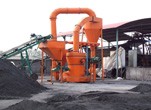After running for a period of time, the dryer cylinder often sinks down. Cylinder sinking has a bad impact on the front and rear interface sealing of the transmission system, reduces exposure precision and causes gear damages.
There are many reasons attributed for slurry dryer cylinder sinking, such as the roller and bearing wear, bolts loose, roller displacement, wear to the inner and outer surfaces of the rolling ring , as well as the wear to the iron pad on the rolling ring.
1) Adjust the clearance, mainly to adjust the clearance between the rolling ring and the pad.
Specific practice: replace a new pad or add a pad to the initial one.
2) Revert the slope, mainly to recover the designed slope of the slurry dryer cylinder.
Specific practice: Adjust the relative height difference of the two supporting devices to reach the specified values in the design.
3) Recover the horizontal position of the cylinder, making the vertical projection of the cylinder generatrix coincides with the zero line of the base once again.
a. When the measured diameters and wear condition of the two rollers on the same gear are equivalent, tune a equidistant distance from the two rollers' axle centerline to the zero line.
b. When the measured diameters are unequal, turn down the distance from the smaller roller to the centerline.
4) Recover the cylinder's vertical position, in order to bring the cylinder back to the due vertical position.
a. Calculate the actual level of the two rolling rings' geometric center, by advancing the rollers symmetrically to adjust the cylinder centerline to the designed level.
b. According to the clearance size between the front and rear sealing rings with cylinder radial, in addition to referring to that between the big gear ring and the pinion top, determine the volume to adjust and finish it once.


